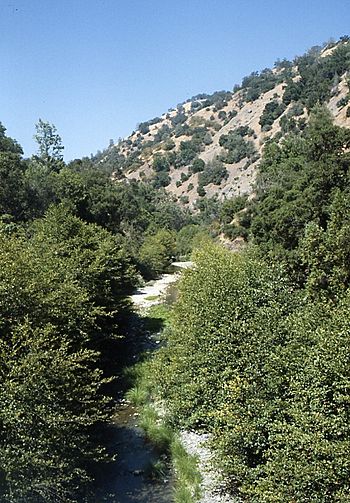Arroyo Hondo (Santa Clara County) facts for kids
Quick facts for kids Arroyo Hondo |
|
|---|---|

Summer low flows in Arroyo Hondo with riparian white alder and foothill pine, Courtesy of Robert A. Leidy PhD, U.S. EPA
|
|
| Country | United States |
| State | California |
| Region | Santa Clara County |
| Physical characteristics | |
| Main source | Confluence of Smith Creek and Isabel Creek 1,585 ft (483 m) 37°23′00″N 121°41′34″W / 37.38333°N 121.69278°W |
| River mouth | Joins Calaveras Creek in Calaveras Reservoir 771 ft (235 m) 37°27′51″N 121°46′36″W / 37.46417°N 121.77667°W |
Arroyo Hondo is a creek in Santa Clara County, California, United States. It flows towards the northwest and is about 13-mile-long (20.9 km). This creek is located east of Milpitas.
The land around Arroyo Hondo is privately owned by the San Francisco Water Department. Because the water from this creek is used for drinking, people are not allowed to visit the area. Arroyo Hondo flows into the Calaveras Reservoir, where it joins Calaveras Creek. The creek starts where two smaller creeks, Smith Creek and Isabel Creek, meet. These two creeks drain water from the western and eastern sides of Mount Hamilton.
Contents
What's in a Name? The History of Arroyo Hondo
The name Arroyo Hondo comes from the Spanish words meaning "deep creek."
Mount Hamilton and Isabel Creek
The creek called Isabel Creek has an interesting history connected to Mount Hamilton. Long ago, the Spanish name for Mount Hamilton was Sierra de Santa Isabel. The highest point was even called Mount Isabel.
In 1861, explorers William Henry Brewer and Charles Hoffman from the Whitney Survey climbed the peak. They didn't know it already had a name. So, they decided to call it Mount Hamilton. However, they did correctly mark Isabel Valley on their map.
Later, in 1895, the USGS found another peak nearby. This peak was about two miles (3.2 km) southeast of Mount Hamilton and just as tall (4,193 feet; 1,278 m). They correctly named this peak Mount Isabel.
Where Does the Water Go? The Watershed
The main part of Arroyo Hondo forms where Isabel Creek and Smith Creek meet. This spot is at the northern tip of Joseph D. Grant County Park. It's about 1,585 feet (483 m) above sea level.
From there, Arroyo Hondo flows north. It eventually reaches the Calaveras Reservoir at an elevation of about 765 feet (233 m). Isabel Creek itself starts even higher, around 2,600 feet (790 m). It flows north through the Isabel Valley, then east and north of Mount Isabel and Mount Hamilton, until it meets Smith Creek.
Arroyo Hondo then joins Calaveras Creek inside the Calaveras Reservoir. Calaveras Creek then flows into Alameda Creek in Alameda County. Finally, Alameda Creek empties into San Francisco Bay. This whole area, from where the water collects to where it flows out, is called a watershed.
Who Lives in the Creek? The Ecology
Arroyo Hondo is home to many interesting animals.
Fish in the Creek
The creek still has some native coastal rainbow trout (Oncorhynchus mykiss irideus). Several groups are working to protect these fish. There are waterfalls in the upper part of Arroyo Hondo that fish cannot pass. However, the rainbow trout in Smith and Isabel creeks are thought to be native. This is because other native fish, like California roach (Hesperoleucus symmetricus) and Sacramento sucker (Catostomus occidentalis occidentalis), are found both above and below these falls.
In 1898, the California Academy of Sciences found a steelhead trout in Isabel Creek. Also, in 1905, John Otterbein Snyder noted that both Smith Creek and Arroyo Hondo were streams where anadromous steelhead trout (fish that migrate from the ocean to fresh water to spawn) lived.
Another type of fish, Speckled dace (Rhinichthys osculus), was found in Arroyo Hondo and Isabel creeks in 1898. However, more recent surveys in 1978 and 2013 did not find them. So, it's not clear if they still live in the creek today.
Frogs in the Area
Two types of frogs, Foothill yellow-legged frogs (Rana boylei) and California red-legged frogs (Rana draytoni), also live in the upper parts of Alameda, Arroyo Hondo, Smith, and Isabel creeks.
Images for kids
See Also


